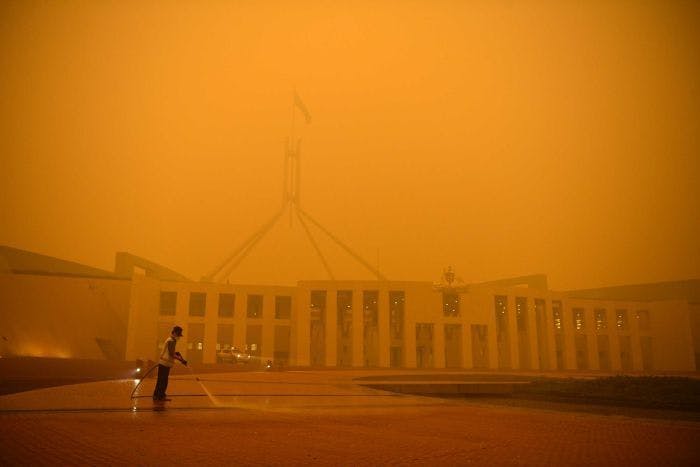Canberra chokes on toxic smoke

The new year was welcomed in Canberra amid orange and grey air and a red sun so dimmed you could stare right at it. Those who had no choice but to venture out did so wearing masks, while others without masks used their arms and shirts to cover their mouths. Walking through the city centre, the wail of multiple fire alarms was incessant, almost drowning out the sounds of people coughing and vomiting in the haze. Other than that, silence.
Only upon entering the air-conditioned shopping malls was it possible to appreciate how much smoke has permeated clothes, hair and airways. These centres were full, the din of fire alarms preferable to breathing smoke. But the reprieve didn’t last long – many of these centres closed during the worst of the smoke. Multiple public places that could have provided refuge for people, including the Portrait Gallery, Questacon, Australian National University, University of Canberra, post offices, and public pools – were closed. Hospitals had to cancel medical procedures because of the effect smoke was having on their buildings and equipment. The health effects of the smoke are impossible to quantify, and may take many years to manifest. One woman has already died after going into respiratory distress shortly after arriving by plane in Canberra.
If it was any other summer, the government may have been able to weather this crisis, even benefit from it, by appealing to “national unity” and praising everyone’s bravery or stoicism. Not this year. Not in an age when the impending climate catastrophe has become undeniable, and its effects no longer simply a matter of speculation. What this summer also shows is that the effects of the climate crisis will not impact us all equally. Capitalism’s inequality permeates everything, even the air we breathe.
The logical thing to do when a city’s air quality rapidly becomes the worst in the world and dangerous to human health is to evacuate people to where the air is breathable. But leaving the city is not feasible for most people. We don’t all have the necessary money, holidays or work arrangements that permit us to take off to Hawaii whenever the mood takes us. Nor do we have second homes to retreat to or friends with large houses in far flung parts of the country.
The next best thing after evacuation would be to protect people from the smoke. But somehow in spite of the God-ordained laws of supply and demand, masks have been in short supply, with most shops running out weeks ago. On 1 January at 1am, Canberra’s air quality reading index reached 7,700, more than 38 times what is considered hazardous. Advice from ACT Health read, “Everyone should avoid all physical activity outdoors. Sensitive groups should temporarily relocate to a friend or relative living outside the affected area. If this is not possible, remain indoors and keep activity levels as low as possible”. It wasn’t until 6 January, almost a full week later, that the government deigned to send masks. A mass poisoning was taking place, but getting protective masks to Canberrans was not a priority.
Staying indoors was no protection for many people, especially those in Canberra’s infamous rental properties. Many rentals in Canberra have no insulation, do not seal, and have no air conditioning. They’re so inadequate that an estimated 42 people die in them each winter because of the cold. There’s no chance of keeping poison smoke out of houses like that. Air-conditioned public spaces initially offered some refuge, but they too gradually succumbed to smoke. Desperate renters share advice on community facebook pages, including suggesting putting wet towels over holes, vacuuming the air if you can’t afford an air filter and keeping pets inside overnight so they don’t die.
Rightly, some workplaces have shut down due to the risk posed by working in the toxic air. So far this has been driven by the companies, not the unions. But with poor air quality likely to be the new normal, businesses will not be willing to forgo profits in this way for long periods. Workers need the pro-active backing of their unions if they’re to be properly protected at work.
Fire itself is also a direct risk to Canberra, yet ACT firefighters are under-resourced. Since 2015, the union has been asking the government for 94 more firefighters, new fire stations, trucks, and upgraded training.
This is the battleground of the climate crisis – smoke, fire, flood, storms, and drought will increasingly impact major cities. Businesses will not willingly pay for safety equipment for all workers, nor close every time there’s poor air quality and continue to pay wages. Landlords will not pay for high-quality air purifiers to be installed and maintained in every home. Everywhere we turn, there will be a capitalist, landlord, or politician standing in the way of real environmental justice.
The fossil fuel companies who have made their billions from creating this hell receive $29 billion in government subsidies every year. And in the face of this deadly chaos, they are pursuing new environmentally destructive projects like the Adani Carmichael mine. This money should be used to fund renewable projects, pay volunteer firefighters, fully equip the fire fighting force, modify homes to make them fit for habitation in heat, cold, and smoke, supply masks for all, rebuild the homes lost in the fires, and much more. For a response to the crisis that isn’t a dystopic nightmare, we need to reject the politics of national unity, of “we’re all in this together”, and revive the politics of knowing and fighting our enemy.